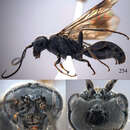Description
(
anglais
)
fourni par Zookeys
Redescribed after a female from Liaoning, length of body 10.9 mm (of fore wing 8.2 mm).
Head. Antenna with 26 segments; frons densely and finely punctate (Fig. 255); vertex and temple largely smooth with sparse and fine punctures (Figs 256, 259); head gradually narrowed behind eyes, eye in dorsal view 0.7 times as long as temple (Fig. 256); occipital carina strongly widened and lamelliform, coarsely crenulate medio-dorsally (Fig. 256); supra-antennal elevations strongly enlarged (about 1.1 times as long as scapus), outer side flat and smooth (Fig. 256); clypeus slightly concave and thick medio-ventrally.
Mesosoma. Length of mesosoma 1.4 times its height (Fig. 261); mesopleuron transversely reticulate-rugose anteriorly, rugulose to smooth posteriorly; transverse mesopleural groove moderately wide, deep and coarsely crenulate; notauli moderately wide, deep and coarsely crenulate; middle lobe of mesoscutum largely densely punctate and rugose at posterior end, lateral lobes mainly finely rugose (Fig. 260); scutellar sulcus wide, both medially and laterally and coarsely crenulate; scutellum densely reticulate-punctate, rather flat and anteriorly near level of mesoscutum; metanotum medially protruding, obtusely bifurcate dorsally and reticulate-rugose (Fig. 260); anterior propodeal sulcus crenulate-rugose and more or less widened medially; propodeum largely coarsely reticulate-rugose except for small smooth area on antero-lateral and posterior margin (Fig. 260); posterior propodeal carina thick lamelliform and curved, foramen medially 0.4 times higher than wide basally.
Wings. Fore wing: length of vein 1-M 1.4 times as long as vein 1-SR (Fig. 258).
Metasoma. First tergite 0.6 times as long as apically wide, smooth and with distinct elliptical depression antero-medially (Fig. 262); second–fifth tergites largely smooth except for sparse superficial punctures; first and second sternites largely smooth except for sparse superficial punctation, third–fifth sternites densely and superficially punctate (Fig. 264); second sternite slightly convex (Fig. 263); third sternite about 0.3 times as long as second sternite (Fig. 264); hypopygium triangular in ventral view.
Colour. Black; malar space ivory; mandibular teeth, palpi, tegulae, fore and mid tibiae and tarsi dark brown; pterostigma and posterior half of first submarginal cell to anterior third of marginal cell of fore wing and area below it dark brown, remainder of wing membrane pale brown.
Variation. Length of body 9.4–11.5 mm, of fore wing 7.9–8.9 mm; antenna of ♀ with 25 (1), 26 (2) or 28 (1) segments; propodeum coarsely rugose anteriorly, transversely striate medially and smooth posteriorly; length of vein 1-M of fore wing 1.4–1.9 times as long as vein 1-SR.
Male. Length of body 11.3 mm, of fore wing 9.2 mm; antenna with 25 segments, tyloids nearly circular, 0.2 times as long as segment on 11th–15th segments (Fig. 266); genitalia extruded; third–seventh tergites densely and superficially punctate.
- licence
- cc-by-3.0
- droit d’auteur
- Hua-yan Chen, Cornelis van Achterberg, Jun-hua He, Zai-fu Xu
- citation bibliographique
- Chen H, van Achterberg C, He J, Xu Z (2014) A revision of the Chinese Trigonalyidae (Hymenoptera, Trigonalyoidea) ZooKeys 385: 1–207
- auteur
- Hua-yan Chen
- auteur
- Cornelis van Achterberg
- auteur
- Jun-hua He
- auteur
- Zai-fu Xu
Distribution
(
anglais
)
fourni par Zookeys
China (Liaoning, Inner Mongolia, Beijing, Hebei and Henan); Russia; Ukraine; Kazakhstan; Mongolia; Western Europe (Lelej 2003).
- licence
- cc-by-3.0
- droit d’auteur
- Hua-yan Chen, Cornelis van Achterberg, Jun-hua He, Zai-fu Xu
- citation bibliographique
- Chen H, van Achterberg C, He J, Xu Z (2014) A revision of the Chinese Trigonalyidae (Hymenoptera, Trigonalyoidea) ZooKeys 385: 1–207
- auteur
- Hua-yan Chen
- auteur
- Cornelis van Achterberg
- auteur
- Jun-hua He
- auteur
- Zai-fu Xu

